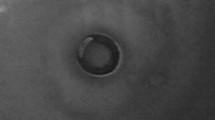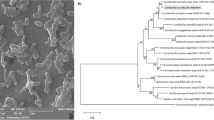Abstract
The bacterial strain KR-12 was isolated from river sediment in northeast Taiwan. 16S rRNA gene sequencing revealed that it belongs to the genus Shewanella. The strain can accumulate lead (Pb) and form Pb nanoparticles (PbNPs) on exposure to Pb(NO3)2 and sodium formate in HEPES buffer. On transmission electron microscopy (TEM), the KR-12-formed PbNPs were spherical in shape and ranged from 3 to 8 nm. The PbNPs formed a line or curved pattern on bacteria. In addition, one or more pilus-like structures elongated from the bacteria. In contrast, Shewanella oneidensis MR-1 and other bacteria could not form PbNPs pattern or pilus-like structure under the same conditions. High-resolution TEM combined with energy-dispersive X-ray spectroscopy demonstrated that these PbNPs primarily contained Pb and had an amorphous structure. This is the first report of the biosynthesis of PbNPs by a Shewanella species.






Similar content being viewed by others
References
Adriano DC (2001) Trace elements in terrestrial environments, 2nd edn. Springer-Verlag, New York
Aiking H, Govers H, van’t Riet J (1985) Detoxification of mercury, cadmium, and lead in Klebsiella aerogenes NCTC 418 growing in continuous culture. Appl Environ Microbiol 50:1262–1267
Al-Aoukaty A, Appanna VD, Huang J (1991) Exocellular and intracellular accumulation of lead in Pseudomonas fluorescens ATCC 13525 is mediated by the phosphate content of the growth medium. FEMS Microbiol Lett 83:283–290
Arakaki A, Nakazawa H, Nemoto M, Mori T, Matsunaga T (2008) Formation of magnetite by bacteria and its application. J R Soc Interface 5:977–999
Bazylizinki DA, Heywood BR, Mann S, Frankel RB (1993) Fe3O and Fe3S4 in a bacterium. Nature 366:218
Bruins MR, Kapil S, Oehme FW (2000) Microbial resistance to metals in the environment. Ecotoxicol Environ Saf 45:198–207. doi:10.1006/eesa.1999.1860
Chen C-H, Chang C-F, Ho C-H, Tsai T-L, Liu S-M (2008) Biodegradation of crystal violet by a Shewanella sp. NTOU1. Chemosphere 72:1712–1720. doi:10.1016/j.chemosphere.2008.04.069
De Windt W, Aelterman P, Verstraete W (2005) Bioreductive deposition of palladium (0) nanoparticles on Shewanella oneidensis with catalytic activity towards reductive dechlorination of polychlorinated biphenyls. Environ Microbiol 7:314–325. doi:10.1111/j.1462-2920.2005.00696.x
Eden PA, Schmidt TM, Blakemore RP, Pace NR (1991) Phylogenetic analysis of aquaspirillum magnetotacticum using polymerase chain reaction-amplified 16S rRNA-specific DNA. Int J Syst Bacteriol 41:324–325
El-Naggar MY, Gorby YA, Xia W, Nealson KH (2008) The molecular density of states in bacterial nanowires. Biophys J 95:L10–L12. doi:10.1529/biophysj.108.134411
El-Naggar MY et al (2010) Electrical transport along bacterial nanowires from Shewanella oneidensis MR-1. Proc Natl Acad Sci USA 107:18127–18131. doi:10.1073/pnas.1004880107
Fairbrother L, Etschmann B, Brugger J, Shapter J, Southam G, Reith F (2013) Biomineralization of gold in biofilms of Cupriavidus metallidurans. Environ Sci Technol 47:2628–2635. doi:10.1021/es302381d
Felsenstein J (1985) Confidence limits on phylogenies: an approach using the bootstrap. Evolution 39:783–791. doi:10.2307/2408678
Gadd GM (1992) Microbial control of pollution. Society for General Microbiology Symposia, vol Book 48, 1st edn. Cambridge University Press, Cambridge
Jiang S, Hur HG (2013) Effects of the anaerobic respiration of Shewanella oneidensis MR-1 on the stability of extracellular U(VI) nanofibers. Microbes Environ 28:312–315
Konishi Y, Tsukiyama T, Saitoh N, Nomura T, Nagamine S, Takahashi Y, Uruga T (2007) Direct determination of oxidation state of gold deposits in metal-reducing bacterium Shewanella algae using X-ray absorption near-edge structure spectroscopy (XANES). J Biosci Bioeng 103:568–571. doi:10.1263/jbb.103.568
Levinson HS, Mahler I (1998) Phosphatase activity and lead resistance in Citrobacter freundii and Staphylococcus aureus. FEMS Microbiol Lett 161:135–138. doi:10.1111/j.1574-6968.1998.tb12939.x
Lin JG, Chen SY, Su CR (2003) Assessment of sediment toxicity by metal speciation in different particle-size fractions of river sediment. Water Sci Technol 47:233–241
Luo X et al (2014) Isolation and characterization of a radiation-resistant bacterium from Taklamakan Desert showing potent ability to accumulate lead (II) and considerable potential for bioremediation of radioactive wastes. Ecotoxicology 23:1915–1921. doi:10.1007/s10646-014-1325-4
Marshall MJ et al (2006) c-Type cytochrome-dependent formation of U(IV) nanoparticles by Shewanella oneidensis. PLoS Biol 4:e268. doi:10.1371/journal.pbio.0040268
Massadeh AM, Al-Momani FA, Haddad HI (2005) Removal of lead and cadmium by halophilic bacteria isolated from the Dead Sea shore, Jordan. Biol Trace Elem Res 108:259–269. doi:10.1385/BTER:108:1-3:259
Mayer RA, Godwin HA (2006) Preparation of media and buffers with soluble lead. Anal Biochem 356:142–144. doi:10.1016/j.ab.2006.02.032
Mire CE, Tourjee JA, O’Brien WF, Ramanujachary KV, Hecht GB (2004) Lead Precipitation by Vibrio harveyi: evidence for novel quorum-sensing interactions. Appl Environ Microbiol 70:855–864. doi:10.1128/AEM.70.2.855-864.2004
Myers CR, Nealson KH (1988) Bacterial manganese reduction and growth with manganese oxide as the sole electron acceptor. Science 240:1319–1321. doi:10.1126/science.240.4857.1319
Park JH, Bolan N, Megharaj M, Naidu R, Chung JW (2011) Bacterial-Assisted Immobilization of Lead in Soils implication for remediation. Pedologist 54:162–174
Perdrial N, Liewig N, Delphin J-E, Elsass F (2008) TEM evidence for intracellular accumulation of lead by bacteria in subsurface environments. Chem Geol 253:196–204. doi:10.1016/j.chemgeo.2008.05.008
Reguera G, McCarthy KD, Mehta T, Nicoll JS, Tuominen MT, Lovley DR (2005) Extracellular electron transfer via microbial nanowires. Nature 435:1098–1101. doi:10.1038/nature03661
Saitou N, Nei M (1987) The neighbor-joining method: a new method for reconstructing phylogenetic trees. Mol Biol Evol 4:406–425
Scheffel A, Gruska M, Faivre D, Linaroudis A, Plitzko JM, Schuler D (2006) An acidic protein aligns magnetosomes along a filamentous structure in magnetotactic bacteria. Nature 440:110–114. doi:10.1038/nature04382
Schüler D (2008) Genetics and cell biology of magnetosome formation in magnetotactic bacteria. FEMS Microbiol Rev 32:654–672
Seong S, Park TH (2001) Swimming characteristics of magnetic bacterium, Magnetospirillum sp. AMB-1, and implications as toxicity measurement. Biotechnol Bioeng 76:11–16. doi:10.1002/bit.1021
Smeaton CM, Fryer BJ, Weisener CG (2009) Intracellular precipitation of Pb by Shewanella putrefaciens CN32 during the reductive dissolution of Pb–Jarosite. Environ Sci Technol 43:8086–8091
Suresh AK et al (2011) Biofabrication of discrete spherical gold nanoparticles using the metal-reducing bacterium Shewanella oneidensis. Acta Biomater 7:2148–2152. doi:10.1016/j.actbio.2011.01.023
Tam K et al (2010) Growth mechanism of amorphous selenium nanoparticles synthesized by Shewanella sp. HN-41. Biosci Biotechnol Biochem 74:696–700. doi:10.1271/bbb.90454
Todorova SG, Costello AM (2006) Design of Shewanella-specific 16S rRNA primers and application to analysis of Shewanella in a minerotrophic wetland. Environ Microbiol 8:426–432. doi:10.1111/j.1462-2920.2005.00908.x
van Veen HW, Abee T, Kortstee GJ, Konings WN, Zehnder AJ (1994) Substrate specificity of the two phosphate transport systems of Acinetobacter johnsonii 210A in relation to phosphate speciation in its aquatic environment. J Biol Chem 269:16212–16216
Wang H, Law N, Pearson G, van Dongen BE, Jarvis RM, Goodacre R, Lloyd JR (2010) Impact of silver(I) on the metabolism of Shewanella oneidensis. J Bacteriol 192:1143–1150. doi:10.1128/JB.01277-09
Xiao X et al (2015) Photocatalytic properties of zinc sulfide nanocrystals biofabricated by metal-reducing bacterium Shewanella oneidensis MR-1. J Hazard Mater 288:134–139. doi:10.1016/j.jhazmat.2015.02.009
Yan L, Zhang S, Chen P, Liu H, Yin H, Li H (2012) Magnetotactic bacteria, magnetosomes and their application. Microbiol Res 167:507–519. doi:10.1016/j.micres.2012.04.002
Acknowledgments
The authors are grateful to the Electron Microscopy Laboratory, Veterinary Medicine of National Taiwan University for the TEM analysis and financial support from the Ministry of Science and Technology, Executive Yuan, Taiwan (grant no. NSC 101-2313-B-002-013 and NSC 102-2313-B-002-044).
Author information
Authors and Affiliations
Corresponding author
Rights and permissions
About this article
Cite this article
Liu, CL., Yen, JH. Characterization of lead nanoparticles formed by Shewanella sp. KR-12. J Nanopart Res 18, 30 (2016). https://doi.org/10.1007/s11051-015-3309-6
Received:
Accepted:
Published:
DOI: https://doi.org/10.1007/s11051-015-3309-6




